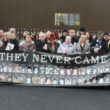The latest Irish Times (IPSOS/MRBI) opinion poll has been widely discussed in the media in recent days, with claims being made that it heralds the rising from the grave of Fianna Fail. In reality, this is a gross spinning of the facts and an attempt by the media and the establishment to demoralise anti-austerity activists, and rehabilitate Fianna Fail.
Reports of Fianna Fail’s rebirth are greatly exaggerated
According to the Independent: “A new opinion poll has placed Fianna Fail at the top of the popularity chart for the first time since the onset of the financial crisis almost five years ago”, while the Irish Times were even more fawning saying “Fianna Fáil has confounded the critics who wrote the party’s obituary after its election disaster two years ago, with today’s poll putting it back on top of the political world.”
Behind all of this is the most recent IPSOS / MRBI poll whose results were printed in the Irish Times on Saturday, which did indeed show Fianna Fail as having more support that Fine Gael, Labour or Sinn Fein. However, these figures are only in anyway significant when so-called ‘undecided’ voters – those who don’t want to vote for any of the parties – are excluded. With this group now making up more than one third of voters, excluding them greatly distorts the support for the parties including Fianna Fail.
In concrete terms, 2 years again in a simlar IPSOS / MRBI poll, 13% of those asked who they would vote for chose Fianna Fail. For a party that had generally got at least 40% of the vote in elections, this was an absolute collapse. Two years out of government, and the recovery of there vote has been tiny. In the past year their support has varied between 12% (April last year) and 17% (February this year), and has still been well below that in Dublin. When you factor in that there is a 3% margin of error with these polls, the so-called recovery looks as shaky as the often proclaimed economic recovery.
So what is happening in the polls?
The real story form the opinion polls is two-fold: on the one hand a drastic fall in the Fine Gael and particularly the Labour Party vote, and secondly that this anger has not been reflected in a real rise in any of the parties, instead there has been a dramatic rise in ‘undecideds’.
As Graph 1 shows, the past 2 years have seen a huge fall in Fine Gael’s support in the IPSOS / MRBI polls from 30% to 16%. Labour’s support has collapsed even further, from 16% to 6%. Along side this, 77% are of people are dissatisfied with government policy. Even among those who still say they would vote Labour, 72% are not happy with the government, and 39% are unhappy with Gilmore – a sign that the Labour support can collapse even more.
So the government parties have lost a combined 24% – where have these former Fine Gael & Labour voters gone? As Graph 2 shows, up to 4% have returned to Fianna Fail (bring them to 17%), whilst 3% have gone to Sinn Fein (now on 12%) and 2% to the Left & Independents (now on 14%). But the vast majority have joined the ‘undecideds’ who support none of the parties. At 34% of voters, this block is now bigger than the combined votes of the two ‘pillar parties’ of Irish Capitalism, Fianna Fail and Fine Gael. In fact, even adding in Labour, the 3 main pro-austerity establishment parties now have less than 40% of the voters supporting them. Interestingly, the situation is even worse for the establishment in Dublin, where the Left & Independents have 32% of the decided voters, compared to 11% for Fianna Fail.
A huge vacuum for a new anti-austerity, anti-capitalist political alternative
These figures completely disprove the media’s argument that Fianna Fail has a huge momentum behind them. In reality, this is wishful thinking from the establishment. In fact, they show a developing political crisis for the Irish capitalist establishment, as all their parties lie in tatters, and a huge vacuum on the left is opening up.
However, we cannot count our chickens before they hatch. These polls indicate the huge anger and desire for a principled, working class alternative. However, such a political alternative must be built to fill that vacuum, otherwise, we could face a continuation of the status quo, a different variation of the right wing parties in government, or even some new non-Left force emerging. Last years fight against the Household Tax, which saw thousands of ordinary working people get active, as well as the huge battle to come on the property tax indicate that there is the potential for such a serious political alternative and challenge to be built, on a solid foundation of thousands of fresh working class activists.












